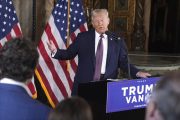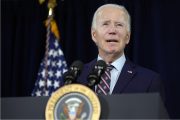A blatant propaganda campaign is underway in the Council on Foreign Relations-dominated major media aimed at convincing Americans that “Islamic fundamentalism” is the new global threat we must prepare to battle. According to the managers of public opinion, the new Muslim threat is not only more sinister than any residual communist menace, but is probably more dangerous than communism ever was.
It would, no doubt, strike the uninformed as very odd then to learn that the same Council on Foreign Relations (CFR) operatives in government and the media who are most loudly declaiming against the scourge of “militant” and “fundamentalist” Islam are indeed the very strategists who are most responsible for the policies and actions (both past and present) that have built, and continue to aid, the most fanatical, anti-American, “Islamic fundamentalist” regimes and organizations in the world today. Odd, that is, unless these regimes and organizations are serving a hidden purpose. Quite obviously, that is the case. Iran, Iraq, Syria, Libya, Algeria, the PLO, the Muslim Brotherhood, and a host of others in the extremist camp — most recently Afghanistan — have been built into menacing perils to, among other things, justify the transformation of the UN’s blue helmets into global gendarmes capable of enforcing UN dictates on all peoples and nations.
Iran was the first major victim in this scheme. Iran under Shah Reza Pahlavi was the West’s strongest ally in the region and a force for moderation, modernization, and advancement of human fights. But to Jimmy Carter and the CFR cabal surrounding him, Iran was to be the starting domino in a chain reaction designed to usher in the new world order. Khomeini’s “fundamentalists” didn’t overthrow the Shah, as the media myth makers would have you believe; Carter and company did that. While the Establishment media cartel smeared the Shah as a latter-day Hitler, the Carter Administration pulled every deception and dirty trick imaginable to undermine the Pahlavi rule. UN Ambassador Andrew Young (CFR) added to the media image of Ayatollah Khomeini (then in exile) as a great holy man, declaring that “he will be hailed as a saint” when he returns to Teheran. In the final act, General Alexander Haig (CFR) sent his deputy commander, General Robert Huyser, to warn the Iranian military against supporting their emperor. As General Amir Houssein Rabii, commander of the Iranian Air Force, saw it, Huyser took the Shah “by the tail and threw him out of the country like a dead mouse.”
Iraqi Counterbalance
No sooner was the U.S.-led Iranian coup completed than the CFR brain trust in our foreign policy establishment cited “balance-of-power” imperatives to justify pouring hundreds of millions (and then billions) of dollars of aid, technology, and military assistance into Saddam Hussein’s Iraq. Saddam, the CFR double domes in the Reagan-Bush Administrations assured us, would be our protection against the Khomeini strain of virulent Islam. During the eight-year Iran-Iraq War, Washington sold weapons to both sides, but clearly “tilted” toward Iraq.
In previous articles, this magazine has detailed the decade-long U.S. buildup of Saddam’s war machine in spite of his continued mortal hostility toward the U.S., his support for terrorism, and his criminal use of poison gas on his own civilian population.
Investigations by the House Banking Committee and journalists have carefully documented a sordid trail of treachery and treasonous actions by George Bush and his retinue before, during, and after the Persian Gulf War. One of the latest and most comprehensive exposés of this whole affair is provided in the new book, Spider’s Web: The Secret History of How the White House Illegally Armed Iraq, by Financial Times of London correspondent Alan Friedman (reviewed in The New American, February 21, 1994). The U.S. provided, or assisted Iraq in obtaining cluster bombs, technology for nuclear enrichment, U.S.-designed munitions, missile technology, some $5 billion in loan guarantees, and much more. When the shooting started in Desert Storm, Mr. Bush’s CFR coterie had us bedding down with Assad of Syria, Saddam’s rival for the title of “Maximum Terrorist Leader.”
New Afghan Threat
The bombing of the World Trade Center may have signaled the rise of a new terrorist center — Kabul, Afghanistan. The Arab suspects in the case, reportedly tied to Sheik Omar Abdul Rahman, received their training during the Afghan War from mujahaddin groups trained and supplied by the CIA. The Sheik has been closely allied with Gulbaddin Hekmatyar, leader of one of the most radical elements of the Afghan mujahaddin, and the one most favored by U.S. intelligence. We may yet learn that our nation’s most spectacular terrorist bombing was brought to us courtesy of the CIA, either indirectly and unintentionally — or, perhaps, directly and intentionally. What, our own CIA implicated? Too wild to believe? Not if you’re familiar with “the Company” and its Afghan campaign.
Carter’s ousting of the Shah and installation of Khomeini in February 1979 was the signal that set in motion the Soviet invasion of Afghanistan later that year. The communist occupation of the country and brutal campaign of genocide against the Afghan people were the putative inspirations for the ensuing U.S. government program of aid to the Afghan mujahaddin. Strange, then, that year after year, right up to the present, American money, arms, and friendship have been lavished on those radical forces with no popular following among the Afghans, no effective fighting forces, and little or no records of fighting the Soviet enemy, but with long records of treachery and betrayal, and well known for their open hostility toward America. Meanwhile, the most popular warrior groups that were carrying on the valiant fight against the invaders, and that also happened to be the most moderate and pro-Western, received only crumbs.
Of the seven mujahaddin parties that made up the Afghan allied resistance, U.S. aid flowed overwhelmingly to the three most virulently anti-Western, anti-American parties: Hez-i-Islami (Party of Islam) led by Gulbaddin Hekmatyar; Jamiat-i-Islami (Islamic Society) led by Professor Burhanuddin Rabbani and his military commander Ahmed Shah Masood; and Ittehad Islami (Islamic Unity) led by Professor Abdul Rasul Sayyaf. All of the above had become involved in the radical “Pan-Islam” movement of the Ikhwan (“Muslim Brotherhood”) during the 1960s and ’70s at Kabul University. The biggest obstacles to Pan-Islam, a movement to unite all of Islam in worldwide solidarity, had always been the tribal, regional, national, sectarian, ethnic, and linguistic diversity and fierce independence of the Islamic peoples. However, there are two outside threats to Islamic society that the Pan-Islamists have exploited with considerable success to overcome many of these obstacles: 1) atheistic communism; and 2) Western secularism, materialism, and immorality. What is most disturbing is how time and again the American and Soviet leaders and the CIA and KGB have appeared to be working in tandem to help Pan-Islamism by directly aiding and collaborating with the most radical groups against the more moderate factions.
The Undisputed Favorites
The forces of Hekmatyar and Masood not only received the lion’s share of Western aid (as well as assistance from Khadafi and Saddam Hussein), but were (and remain) the undisputed favorites of the U.S. Information Agency (USIA) and the CFR-controlled media. Sibgratullah Mojadidi, a respected Islamic theologian and religious leader who was elected president of the Afghan government-in-exile by the mujahaddin during the Soviet occupation, and was elected president of the first interim government after the Soviet pullout, tried repeatedly without success to warn U.S. leaders of this “folly.” Mojadidi complained bitterly that the lopsided support for Hekmatyar was immoral and counterproductive since Hekmatyar was murdering his mujahaddin “allies,” collaborating with the communists, and undermining the authority of the mujahaddin government.
Independent observers and journalists like Kurt Lohbeck, author of the important new book, Holy War, Unholy Victory: Eyewitness to the CIA’s Secret War in Afghanistan, also warned repeatedly against the U.S. favoritism toward Hekmatyar and repeatedly were told that the favoritism would end. It didn’t. Lohbeck records in his book a meeting he had with then-U.S. Ambassador to Pakistan Robert Oakley (CFR) in 1988 at which Oakley assured him that aid to Hekmatyar would cease. One year later at a press briefing Oakley stated categorically that Hekmatyar’s aid had been stopped completely. About one week later Lohbeck followed a 50-truck convoy of U.S. weapons and supplies from the Peshawar airport — to Hekmatyar’s camp.
After the Red Army pulled out in 1989, the Soviets continued massive support for their surrogate regime under Najibullah and his “militia” of brigands commanded by General Abdul Rashid Dostam. The U.S. cut off aid to the mujahaddin — with the exception of Hekmatyar’s group, even though by this time Hekmatyar’s double-dealing and assassination of fellow mujahaddin leaders had thoroughly discredited him even among many of his erstwhile admirers in the Western media. Hekmatyar and Masood have done everything possible since the Soviet departure to undermine unity among the mujahaddin factions and turn Kabul into another Beirut.
In 1992, following the fall of the hated Najibullah regime, Masood, the vaunted “Lion of the Panjshir,” joined forces with General Dostam’s KGB-backed militia to drive his long-time rival, Hekmatyar, from Kabul. Masood installed his mentor, Burhanuddin Rabbani, as president, and himself as Minister of Defense.
Now it is Hekmatyar who is allied with Dostam against Masood. Meanwhile, the more moderate Afghan leaders such as Sibgratullah Mojadidi, Mohammad Mohammadi, Sayed Gailani, Rahim Wardak, Younas Khalis, Abdul Haq, Abdul Qadir — whose forces actively fought the communists and who represent the best hope for a stable, peaceful, and pro-Western Afghanistan — have been marginalized, unable to compete against the better-equipped Masood and Hekmatyar factions. During Desert Storm, these Afghan leaders sent a brigade of mujahaddin to fight alongside U.S. troops, while Masood did nothing and Hekmatyar sided with Saddam Hussein.
According to Kurt Lohbeck, the same KGB officials who were operating in Kabul during the Soviet-installed Karmal and Nagibullah regimes are today continuing business as usual under the Rabbani-Masood administration. Lohbeck, the only Western journalist to cover the Afghan war full-time from the front lines from 1983 to 1992, and one of the most knowledgeable outsiders on the internal politics of Afghanistan, told The New American recently that Mahmood Baryalai, the hardcore-communist brother of former dictator Babrak Karmat, is living in a mansion in Kabul and has his own militia and free run of the city, unmolested by Masood’s forces. Which, says Lohbeck, “is amazing, considering he was a high-ranking member of both his brother’s and Najibullah’s governments.” Concerning Sheik Omar Abdul Rahman, Lohbeck said, “The first time I saw Sheik Rahman was at Gulbaddin Hekmatyar’s headquarters in Peshawar [Pakistan]. He has close connections to Gulbaddin, as do most of the other radical fundamentalist [Islamic] groups” from around the world.
We asked Lohbeck how recent was the most recent CIA aid to Masood and Hekmatyar. “Probably this morning, would be my educated guess,” he replied. “It hasn’t stopped.”



